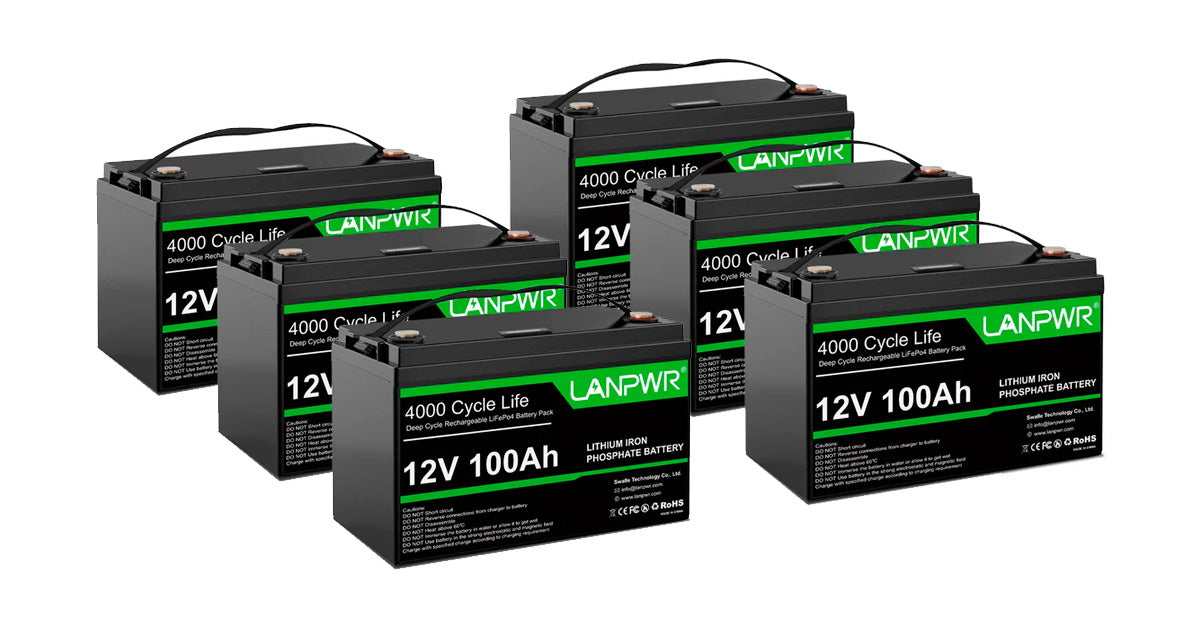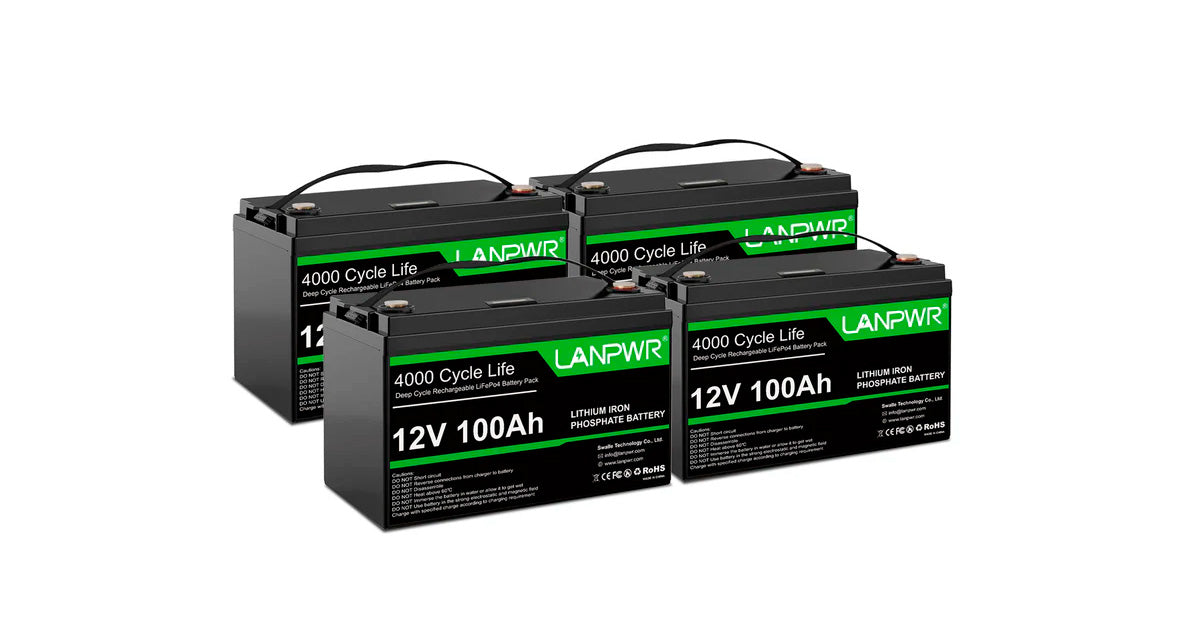Welcome to an in-depth exploration of the LANPWR 12V 100Ah Battery, a standout product in the realm of energy storage. Known for its reliability and efficiency, this guide aims to detail the facets of LiFePO4 technology that make the LANPWR battery a top choice. As we dive into the technical specifications and practical applications, we'll uncover why LANPWR is often heralded as the creator of the world's best batteries.
Understanding LiFePO4 Technology
What is LiFePO4?
LiFePO4 stands for Lithium Iron Phosphate, a battery technology that has gained popularity due to its strong safety profile and long lifecycle. Characterized by its stable chemical composition, LiFePO4 batteries are less prone to thermal runaway than traditional lithium-ion cells, offering a safer alternative for high-energy applications. This section will explore the basic chemistry behind LiFePO4 and how it contributes to its standout features.
LiFePO4 batteries differ significantly from their lithium-ion counterparts, which are more commonly found in everyday electronics like smartphones and laptops. While both technologies share a lithium base, LiFePO4 batteries provide a more stable and robust framework, which results in higher safety and longer battery life. This comparison will delve into the specific advantages that LiFePO4 has over lithium-ion, emphasizing why it's increasingly chosen for demanding energy storage applications.
Advantages of LiFePO4 Batteries
Benefits of LiFePO4
The benefits of LiFePO4 technology are extensive, particularly in terms of safety, stability, and efficiency. These batteries are renowned for maintaining consistent performance over various temperatures and conditions, making them ideal for use in everything from electric vehicles to renewable energy systems. The inherent stability of LiFePO4 chemistry limits the risk of fire and explosion, which is a critical advantage in large-scale energy storage and demanding operational environments.
Another key advantage of LiFePO4 batteries is their remarkable efficiency. Capable of maintaining a high charge density and suffering minimal energy loss during charge and discharge cycles, these batteries optimize the usability of stored energy. These efficiency and environmental safety features, such as non-toxicity and less environmental degradation, position LiFePO4 as a forward-thinking choice for sustainable energy solutions.
LiFePO4 Cycle Life
The cycle life of LiFePO4 batteries is one of their most compelling attributes, often capable of exceeding 2000 complete charge and discharge cycles with minimal capacity loss. This longevity significantly reduces the need for frequent replacements, enhancing the economic appeal of LiFePO4 for both personal and commercial applications. The extended cycle life also contributes to a lower overall cost of ownership compared to other battery technologies that degrade more quickly.
LiFePO4 Safety Features
Safety is a paramount concern in battery technology, and LiFePO4 batteries excel in this area. They are designed with built-in safety mechanisms that prevent overcharging, deep discharging, and excessive current draw, all of which can lead to battery damage and potential safety hazards. These features ensure that LiFePO4 batteries operate within safe parameters, making them suitable for various applications, from home energy storage systems to critical backup power supplies in medical facilities.

LiFePO4 Battery Management Systems (BMS)
Sophisticated battery management systems (BMS) further enhance the effectiveness of LiFePO4 batteries. These systems are crucial for maximizing battery performance, lifespan, and safety. A BMS continuously monitors various parameters such as voltage, current, and temperature, making real-time adjustments to maintain optimal conditions across the battery pack. This proactive management helps prevent the conditions that lead to battery failure and extends the battery's usable life.
LiFePO4 BMS technologies have evolved to include features like cell balancing, state of charge (SOC) estimation, and state of health (SOH) monitoring, providing a comprehensive overview of battery performance and health. These advancements improve the user experience by providing detailed battery insights and contribute to the energy storage system's overall reliability and efficiency. Integrating these technologies into LiFePO4 batteries underscores their suitability for applications where performance and safety cannot be compromised.
Applications and Uses of LiFePO4 Batteries
Common Applications of LiFePO4
LiFePO4 batteries are highly versatile, supporting various applications where durability and efficiency are crucial. In the realm of renewable energy, LiFePO4 is often used in solar power setups, providing a reliable storage solution that maximizes the use of generated solar energy. These batteries are particularly effective in solar systems due to their ability to handle deep discharge cycles, making them ideal for storing solar power during peak production times and using it during off-peak hours.
In marine applications, LiFePO4 batteries offer advantages such as resistance to corrosion and reduced weight, which are critical in harsh marine environments. Their reliability and long lifespan also make them a preferred choice for powering electrical systems on boats, where consistent and safe power is necessary. Additionally, the robust nature of LiFePO4 batteries ensures they perform well in the variable conditions experienced in marine settings, including temperature fluctuations and high humidity.
DIY Projects with LiFePO4
For enthusiasts and professionals alike, LiFePO4 batteries provide an excellent foundation for DIY energy projects. Their modular nature and scalability allow customization to fit specific project requirements, whether for portable power solutions or large-scale energy storage systems. This subchapter will offer practical tips and project ideas, showcasing the adaptability of LiFePO4 batteries in various DIY applications.
LiFePO4 batteries' safety features and low maintenance requirements make them particularly appealing for DIY projects. Users can focus more on the creative aspects of their projects without the constant concern for the intricate safety precautions often associated with other types of batteries. From building custom battery packs for camping trips to designing power systems for off-grid living, LiFePO4 batteries empower individuals to innovate and implement practical energy solutions tailored to their needs.

Performance and Maintenance
Optimizing Battery Life
Understanding the factors that influence the lifespan and performance of LiFePO4 batteries is key to maximizing their potential. This section will explore how proper maintenance and usage can significantly extend the life of these batteries, discussing factors such as temperature management, charge cycles, and operational load. Practical tips will be provided to help users optimize the performance of their LiFePO4 batteries, ensuring they get the most out of their investment.
Proper charging practice management is crucial for maintaining the health of LiFePO4 batteries. Avoiding extreme charging states, ensuring the use of compatible chargers, and maintaining a regular charging schedule can all help preserve battery life. Additionally, understanding the battery's capacity and avoiding overloading is important for preventing premature wear and maximizing efficiency.
Charging and Storage
Charging and storing LiFePO4 batteries correctly is vital for maintaining their efficacy and longevity. This subchapter will detail the best practices for charging LiFePO4 batteries, including recommended chargers, charging rates, and techniques to ensure optimal battery health. Additionally, storage guidelines will be discussed, emphasizing the importance of environmental conditions and how they affect battery performance and safety.
Regarding storage, keeping LiFePO4 batteries at a partial state of charge in a cool, dry environment can greatly extend their lifespan. This section will also address common misconceptions about battery storage and provide clear, actionable advice for users to follow. Proper storage extends the battery's life and ensures it retains its capacity and readiness for use when needed.
Choosing the Right Charger
Selecting the right charger for LiFePO4 batteries is more than just a matter of convenience; it's a critical component of battery care that directly impacts performance and longevity. This subchapter will guide readers through the process of choosing a charger that matches the specific needs of their LiFePO4 battery, considering factors such as charge current, voltage compatibility, and the presence of smart charging features.
The importance of using a charger that is specifically designed for LiFePO4 technology cannot be overstated. Such chargers are equipped to handle the unique charging curve and requirements of LiFePO4 batteries, ensuring they are charged efficiently and safely. Recommendations for high-quality chargers and tips for identifying compatible models will be provided, helping users make informed decisions that contribute to optimal battery health.
Buying Guide
Evaluating LiFePO4 Batteries
Several factors should be considered when buying a LiFePO4 battery to ensure that the product meets specific energy needs and budget constraints. This section will cover key considerations such as energy density, discharge rates, and warranty offerings. It will also discuss assessing the quality and reliability of LiFePO4 batteries, providing a checklist for consumers to use when shopping.
Price comparison and budgeting are also crucial elements of the buying process. This subchapter will provide strategies for balancing cost with quality, ensuring buyers can find a LiFePO4 battery that offers value and performance. By understanding the market and the features that affect pricing, consumers can make educated purchases that meet their long-term energy needs.

Weight and Portability
The weight and portability of LiFePO4 batteries are important considerations, especially for applications that require mobility, such as in RVs and marine environments. This section will explore the benefits of the lightweight nature of LiFePO4 batteries and discuss how this influences the installation and transport of these energy systems. Practical tips will be provided for managing weight considerations in various applications, ensuring that the battery system enhances, rather than hinders, mobility.
LiFePO4 batteries offer significant advantages over heavier lead-acid batteries, particularly in terms of ease of handling and reduced structural stress on vehicles and equipment. This subchapter will highlight the practical impacts of reduced weight, such as improved fuel efficiency in mobile applications and easier installation in remote or difficult-to-access locations.
Future and Innovations
Emerging Trends in LiFePO4 Technology
As battery technology evolves, LiFePO4 is at the forefront of innovation, with new advancements continually emerging to enhance its efficiency and usability. This subchapter will explore current trends in LiFePO4 technology, such as energy density and charging speed improvements, and discuss how these developments are set to reshape the landscape of energy storage.
These innovations promise to improve the practical aspects of LiFePO4 batteries and aim to make them more accessible and cost-effective for a wider range of users. By staying informed about these trends, consumers and industry professionals can better anticipate the future direction of battery technology and its potential impacts on global energy solutions.
Environmental Impact and Sustainability
The role of LiFePO4 batteries in sustainable technology is increasingly important as the world seeks greener energy solutions. This subchapter will discuss the environmental benefits of LiFePO4 batteries, such as their non-toxic materials and potential for recycling. It will also examine how these batteries fit into broader efforts to reduce carbon emissions and enhance renewable energy usage.
The sustainability of LiFePO4 batteries extends beyond their operational life. Their ability to be recycled and reused in various applications underscores their role in promoting a circular economy, where materials are used for as long as possible. This discussion will highlight the importance of considering environmental impacts in the choice of battery technology and how LiFePO4 stands out as a responsible and forward-thinking option.
Conclusion
The LANPWR 12V 100Ah Battery represents the pinnacle of LiFePO4 technology, offering unmatched performance, reliability, and safety. As we have explored, the benefits of choosing a LANPWR battery extend across a broad spectrum of applications, making it an ideal choice for anyone seeking a dependable and efficient energy solution. Whether for personal, commercial, or industrial use, the LANPWR 12V 100Ah Battery stands out as one of the best batteries globally, promising to deliver top-tier performance and contribute to a sustainable future.
Call to Action
For those seeking reliable, efficient, and environmentally friendly energy storage solutions, consider the LANPWR 12V 100Ah battery. Trust LANPWR to power your next project or venture with the best that battery technology offers. Choose LANPWR and experience the difference that quality and innovation can make in meeting your energy needs.














Leave a comment
This site is protected by hCaptcha and the hCaptcha Privacy Policy and Terms of Service apply.